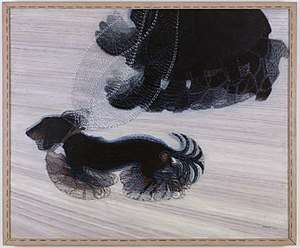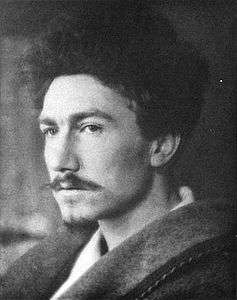Vorticism
Vorticism was a short-lived modernist movement in British art and poetry of the early 20th century,[1] partly inspired by Cubism. The movement was announced in 1914 in the first issue of BLAST, which contained its manifesto and the movement's rejection of landscape and nudes in favour of a geometric style tending towards abstraction. Ultimately, it was their witnessing of unfolding human disaster in World War I that "drained these artists of their Vorticist zeal".[2] Vorticism was based in London but was international in make-up and ambition.

Origins
The Vorticism group began with the Rebel Art Centre which Wyndham Lewis and others established after disagreeing with Omega Workshops founder Roger Fry, and has roots in the Bloomsbury Group, Cubism and Futurism. Lewis himself saw Vorticism as an independent alternative to Cubism, Futurism and Expressionism.[3]
Though the style grew out of Cubism, it is more closely related to Futurism in its embrace of dynamism, the machine age and all things modern (cf. Cubo-Futurism). However, Vorticism diverged from Futurism in the way it tried to capture movement in an image. In a Vorticist painting modern life is shown as an array of bold lines and harsh colours drawing the viewer's eye into the centre of the canvas.
The name Vorticism was given to the movement by Ezra Pound in 1913,[1] although Lewis, usually seen as the central figure in the movement, had been producing paintings in the same style for a year or so previously.[4]
Participants
%2C_Edward_Wadsworth_and_Wyndham_Lewis_1914.jpg)
The eleven signatories of the Vorticist manifesto were:
- Richard Aldington
- Malcolm Arbuthnot
- Lawrence Atkinson
- Jessica Dismorr
- Henri Gaudier-Brzeska
- Cuthbert Hamilton
- Wyndham Lewis
- Ezra Pound
- William Roberts
- Helen Saunders
- Edward Wadsworth
Other contributors to the development of the movement were David Bomberg, Alvin Langdon Coburn, Jacob Epstein (notably Rock Drill), Frederick Etchells, Christopher Nevinson and Dorothy Shakespear.
BLAST
The Vorticists published two issues of the literary magazine BLAST, edited by Lewis, in June 1914 and July 1915.[5] It contained work by Ezra Pound and T. S. Eliot as well as by the Vorticists themselves. In the first issue, Ford Madox Ford, writing under his real name, Ford Madox Hueffer, submitted "The Saddest Story", a ten-page excerpt from the beginning of his novel, 'The Good Soldier'. Its typographical adventurousness was cited by El Lissitzky as one of the major forerunners of the revolution in graphic design in the 1920s and 1930s.
Demise and legacy
Experimental paintings and sculpture using angular simplification and abstraction, by Lewis, Wadsworth, Shakespear and others, were shown at the Rebel Art Centre in 1914, before the formation of the Vorticist Group. This work was contemporary with and comparable to abstraction by European artists such as Wassily Kandinsky, František Kupka and the Russian Rayist Group. The Vorticists held only one exhibition, in 1915, at the Doré Gallery in London.[5] The main section of the exhibition included work by Jessica Dismorr, Frederick Etchells, Lewis, Gaudier-Brzeska, William Roberts, Helen Saunders and Edward Wadsworth. There was a smaller section area titled "Those Invited To Show" that included several other artists. Jacob Epstein was notably not represented, although did have his drawings reproduced in BLAST.[3]
After this, the movement broke up, largely due to the onset of World War I and public apathy towards the work. Gaudier-Brzeska was killed in military service, while leading figures such as Epstein distanced themselves stylistically from Lewis. A brief attempt by Lewis to revive the movement in 1920 under the name Group X proved unsuccessful.[6] Pound, however, through his correspondence with Lewis, was understood to hold a commitment to the goals of the movement as much as forty years after its demise.[7]
While Lewis is generally seen as the central figure in the movement, it has been suggested that this was more due to his contacts and ability as a self-publicist and polemicist than the quality of his works.[7] A 1956 exhibition at the Tate Gallery was called Wyndham Lewis and Vorticism, highlighting his prominent place in the movement. This angered other members of the group. Bomberg and Roberts (who published a series of "Vortex Pamphlets" on the matter)[8] both protested strongly the assertion of Lewis, which was printed in the exhibition catalogue: "Vorticism, in fact, was what I, personally, did, and said, at a certain period."
Recent exhibitions
- The Vorticists: Rebel Artists in London and New York, 1914–18, Nasher Museum of Art at Duke University, 30 September 2010 – 2 January 2011[9][10]
- The Vorticists: Rebel Artists in London and New York 1914–18, Peggy Guggenheim Collection (Venice), 29 January – 15 May 2011
- Vorticists: Manifesto for a Modern World, Tate Britain, 14 June – 4 September 2011
Notes
- West, Shearer (general editor), The Bullfinch Guide to Art History, page 883, Bloomsbury Publishing Plc, United Kingdom, 1996. ISBN 0-8212-2137-X
- Sophie Matthiesson, "Blasted Visions" in Gott et al (2007) p.67
- "Vorticism", MoMA The Collection Retrieved 17 October 2009
- "Program and menu from [[The Cave of the Golden Calf]], Cabaret and Theatre Club, Heddon Street". Archived from the original on 2012-02-16. Retrieved 2006-11-27.
- "Vorticism", Msn Encarta Retrieved 17 October 2009 Archived May 22, 2007, at the Wayback Machine
- "Group X", Tate Retrieved 17 October 2009
- "From Vortex to Vorticism: Ezra Pound's art and science. | Goliath Business News". Goliath.ecnext.com. Retrieved 2010-11-16.
- See John David Roberts, 'A Brief Discussion of the Vortex Pamphlets' Archived 2012-04-04 at the Wayback Machine
- Nasher Museum Archived 2013-03-08 at the Wayback Machine Retrieved 17 September 2010
- Nasher Museum, Alvin Langdon Coburn photographer Retrieved 6 November 2010
References
- Antcliffe, Mark, and Green, Vivien (eds.). The Vorticists. Tate Publishing, 2010.
- Cork, Richard. Vorticism and Abstract Art in the First Machine Age (two volumes). University of California Press, 1976. ISBN 0-520-03154-7 & ISBN 0-520-03269-1.
- Gott, Ted, Laurie Benson, Sophie Matthiesson et al, Modern Britain 1900 - 1960: Masterworks from Australian and New Zealand Collections, Exhibition Catalogue, 2007 National Gallery of Victoria, Melbourne. ISBN 9780724102921
- Haycock, David Boyd. A Crisis of Brilliance: Five Young British Artists and the Great War. Old Street Publishing, 2009.
- Pound, Ezra. "Vorticism" in Fortnightly Review 96, no. 573:461–471, 1914.
External links
- Workshop, a Vorticist painting circa 1914–15 by Wyndham Lewis
- www.vorticism.co.uk, information about Vorticism
- Ezra Pound's 1914 Vorticism essay in The Fortnightly Review
- Ezra Pound: Vorticism
- www.npg.org.uk/wyndhamlewis, Wyndham Lewis exhibition at the National Portrait Gallery, London, 3 July – 19 October 2008
- Tate glossary
- A review of the 2011 Vorticism exhibit at the Tate Britain by Prof. Andrew Thacker.

